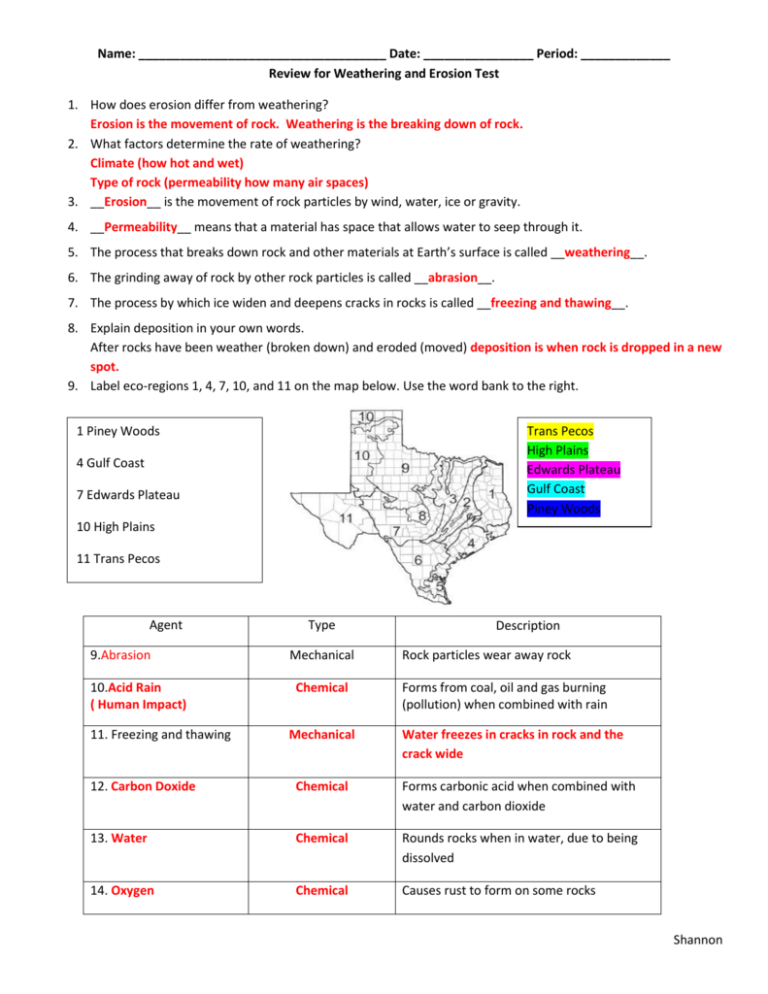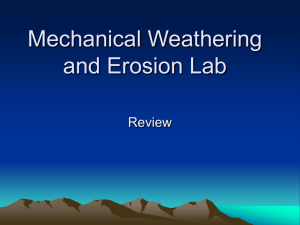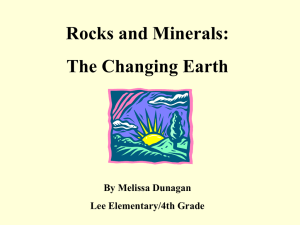Name: Date: Period: ______ Review for Weathering and Erosion
advertisement

Name: ____________________________________ Date: ________________ Period: _____________ Review for Weathering and Erosion Test 1. How does erosion differ from weathering? Erosion is the movement of rock. Weathering is the breaking down of rock. 2. What factors determine the rate of weathering? Climate (how hot and wet) Type of rock (permeability how many air spaces) 3. __Erosion__ is the movement of rock particles by wind, water, ice or gravity. 4. __Permeability__ means that a material has space that allows water to seep through it. 5. The process that breaks down rock and other materials at Earth’s surface is called __weathering__. 6. The grinding away of rock by other rock particles is called __abrasion__. 7. The process by which ice widen and deepens cracks in rocks is called __freezing and thawing__. 8. Explain deposition in your own words. After rocks have been weather (broken down) and eroded (moved) deposition is when rock is dropped in a new spot. 9. Label eco-regions 1, 4, 7, 10, and 11 on the map below. Use the word bank to the right. 1 Piney Woods Trans Pecos High Plains Edwards Plateau Gulf Coast Piney Woods 4 Gulf Coast 7 Edwards Plateau 10 High Plains 11 Trans Pecos Agent 9.Abrasion 10.Acid Rain ( Human Impact) 11. Freezing and thawing Type Mechanical Chemical Mechanical Description Rock particles wear away rock Forms from coal, oil and gas burning (pollution) when combined with rain Water freezes in cracks in rock and the crack wide 12. Carbon Doxide Chemical Forms carbonic acid when combined with water and carbon dioxide 13. Water Chemical Rounds rocks when in water, due to being dissolved 14. Oxygen Chemical Causes rust to form on some rocks Shannon 15. Animal Action Mechanical Animal tunnels or burrows a hole in solil 16. Describe the results of a rock on the bottom of a flowing river. (Hint: What will eventually happen to the rock?) Rock will smooth out and become rounded over time. 17. What is the equation for work? 18. What are the SI units for the following: Force _Newtons_ Work = Force x Distance Distance __Meters__ Work _Joules_ 19. A 100N girl moves a bench 25 m. How much work is done on the bench? 100 N x 25 m = 2,500 Joules 20. How much work is done if a 40,000 N truck is dragged 10m? 40,000 N x 10 m = 400,000 Joules 21. What type of succession occurs after a forest fire? How long will it take to become a climax community? Secondary, approximately 150 years 22. How would a continuous rainfall affect a hilly country side where a wildfire previously occurred? Why would the residence be concerned and what can they do to prevent any further damage? There would be no plants or grass roots to hold the soil in place and the extra amount of water could result in a mudslide. 23. What 2 factors determine the difference between the eco-regions of the western and eastern boarders of Texas? Temperature and precipitation 24. Which of the following might be considered agents of: Weathering Erosion A.Water A. Water B.Wind B. Wind C.Glacier C. Glacier D. Gravity D. Gravity E. Deposition A. Water B. Wind C. Glacier D. Gravirty Shannon









